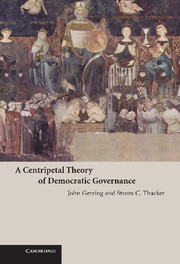Book contents
- Frontmatter
- Contents
- List of Figures
- List of Tables
- Acknowledgments
- A Centripetal Theory of Democratic Governance
- 1 Models of Governance
- PART ONE CAUSAL MECHANISMS
- PART TWO EMPIRICS
- PART THREE CONCLUSIONS
- Appendix A Defining Good Governance
- Appendix B Alternative Theories Revisited
- Sources
- Author Index
- Subject Index
Appendix B - Alternative Theories Revisited
Published online by Cambridge University Press: 06 July 2010
- Frontmatter
- Contents
- List of Figures
- List of Tables
- Acknowledgments
- A Centripetal Theory of Democratic Governance
- 1 Models of Governance
- PART ONE CAUSAL MECHANISMS
- PART TWO EMPIRICS
- PART THREE CONCLUSIONS
- Appendix A Defining Good Governance
- Appendix B Alternative Theories Revisited
- Sources
- Author Index
- Subject Index
Summary
A theory is convincing only to the extent that it outpaces its rivals. Thus, in order to fully evaluate the success of centripetalism in accounting for good governance we must balance its successes and failures against the successes and failures of contending paradigms. In this appendix we return to the primary foil of the narrative, the decentralist model of good government, first introduced in chapter one.
We begin with a reconsideration of the general theory of decentralism, according to which democratic government works best when power is deconcentrated from the center. This theory, we argue, suffers from two major conceptual difficulties. First, it is not clear how decentralized a polity should be (or in what respects) in order to maximize good governance. Second, insofar as the theory rests on an implicit comparison between the operation of politics and markets, it is not clear whether (or in what respects) decentralized polities reproduce the virtues of a free market.
From thence, we proceed to a more focused explication of one influential exemplar of the decentralist ideal. Up to this point we have treated decentralism as if it were a unified theory. Readers conversant with the voluminous literature cited in chapter one are well aware that the label glosses over a great deal of variation. Indeed, some might prefer to call decentralism an orientation, rather than a theory. We are agnostic on this point.
- Type
- Chapter
- Information
- A Centripetal Theory of Democratic Governance , pp. 179 - 190Publisher: Cambridge University PressPrint publication year: 2008



